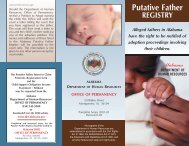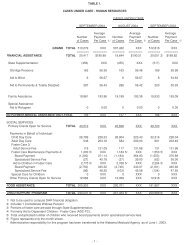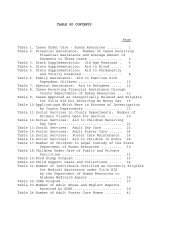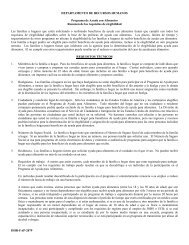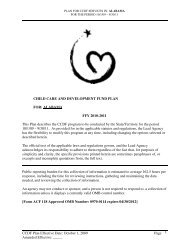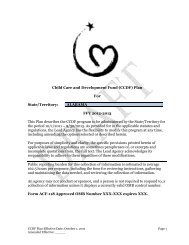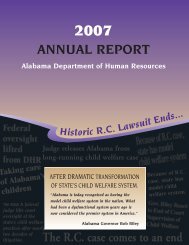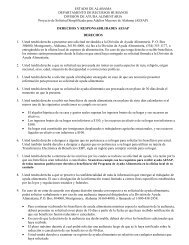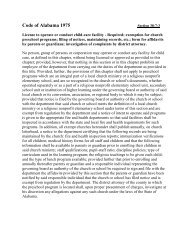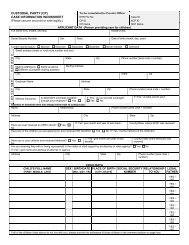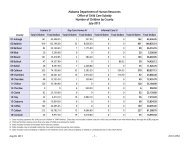04 ANNUAL REPORT 2 - Alabama Department of Human Resources
04 ANNUAL REPORT 2 - Alabama Department of Human Resources
04 ANNUAL REPORT 2 - Alabama Department of Human Resources
- No tags were found...
Create successful ePaper yourself
Turn your PDF publications into a flip-book with our unique Google optimized e-Paper software.
accounts <strong>of</strong> eligible storm victims in accordance withfederal regulations.As the fiscal year drew to a close, DHR was seekingfederal authorization for a disaster food stamp program,which would help families who normally would notqualify. This would help families in need <strong>of</strong> food assistancebecause <strong>of</strong> hurricane-related losses <strong>of</strong> incomeand other financial resources.The DHR State Board presented awards to county departments<strong>of</strong> <strong>Human</strong> <strong>Resources</strong> and to individual state and countyemployees, in recognition <strong>of</strong> exemplary performance duringHurricane Ivan. Recipients included:Baldwin County: Wanda Peavy, Administrative Assistant II; and theBaldwin County DHR.Clarke County: Mary Andrews, Financial Support Supervisor; andthe Clarke County DHR staff.Conecuh County DHR staff.Covington County: Cathy Leverington, Director; and theCovington County DHR.Escambia County: Melinda Robinson, Luella Jackson, Diane Museand the Escambia County DHR.Mobile County: Donna Martin and the Mobile County DHR.Monroe County: Janie Stallworth, Administrative Assistant I; andthe Monroe County DHR.Charles Johnson - Program Administrator, Office <strong>of</strong> EmergencyWelfare Services and Employee Safety.Joyce O’Neal and her staff - The DHR State Board also recognizedFood Assistance Division Director Joyce O’Neal and her stafffor providing expertise and leadership in planning and coordinatingrelief efforts with the USDA, and with state and local governments.FAMILY ASSISTANCEThe number <strong>of</strong> families receiving TemporaryAssistance for Needy Families (TANF) did not increasesignificantly in FY 20<strong>04</strong>. A monthly average <strong>of</strong> 19,266families received welfare payments, compared to amonthly average <strong>of</strong> 19,069 the previous year. Evenwith the slight increase over the past few years, thepublic assistance rolls are still much lower than theywere before passage <strong>of</strong> the federal welfare reform law<strong>of</strong> 1996. The Personal Responsibility and WorkOpportunity Reconciliation Act (Public Law 1<strong>04</strong>-193)made sweeping changes in the nation’s welfare system.The historic legislation imposed a time limit forreceiving welfare benefits, and replaced AFDC (Aid to8The number <strong>of</strong> welfare families in<strong>Alabama</strong> has decreased significantlyin the past eight years.State receives $5.56 million bonusfrom federal <strong>Department</strong> <strong>of</strong> Healthand <strong>Human</strong> Services foroutstanding performance.Families with Dependent Children) with the TANF(Temporary Assistance for Needy Families) BlockGrant. States were given more flexibility in administeringtheir public assistance programs, and were ableto fund job training and support services as lessmoney was required for the declining caseload.With administrative flexibility and the support <strong>of</strong> businessesand other community partners, DHR has beensuccessful in moving recipients from the welfare rollsto jobs. In August 1996 when the welfare reform lawwas signed, almost 41,000 families were receivingmonthly welfare payments in <strong>Alabama</strong>. Eight yearslater, in August 20<strong>04</strong>, there were approximately19,000 welfare families in the state.A successful partnershipThe state received a $5.56 million bonus from the federal<strong>Department</strong> <strong>of</strong> Health and <strong>Human</strong> Services (HHS)for outstanding performance in moving recipientsfrom welfare to work and self-sufficiency. The awardwas based, in part, on <strong>Alabama</strong>’s high ranking in the“Success in the Workforce” category in which currentand former recipients in the state had the eighthbiggest increase in earnings from one year to the next.The state was ranked number one in having thebiggest increase in food stamp participation amongeligible low-income working families with children.The agency worked with faith-based organizations andother agencies to plan and conduct a statewide fatherhoodconference that was held in June 20<strong>04</strong>. Thedepartment continued the <strong>Alabama</strong> FatherhoodInitiative, which helps fathers obtain better jobs andincrease their earnings. With higher wages, they arebetter able to support their children.For several years, a steady decline in the number <strong>of</strong><strong>Alabama</strong> welfare families, coupled with some flexibilityin federal law, meant that TANF money could beused to meet other needs. Federal law permits statesto transfer some TANF funds to the Social Services



